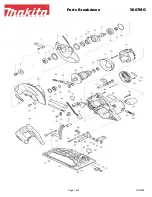
7
POWER CONNECTIONS
This saw is equipped with a
15-amp motor
for use with a 120-
volt, 60-HZ alternating current. See instructions below regarding
proper connections for your saw. For voltage, the wiring in a shop
is as important as the motor’s rating. A line intended only for
lights may not be able to properly carry the current needed for a
power tool motor; wire that is heavy enough for a short distance
may be too light for a greater distance; and a line that can
support one power tool may not be able to support two or three.
A separate electrical circuit should be used for your machines.
This circuit should not be less than #12 wire and should be
protected with a 20-amp time lag fuse. Before connecting the
machine to the power line, make sure the switch is in the “OFF”
position and be sure that the electric current is of the same
characteristics as indicated on the machine. A substantial voltage
drop will cause a loss of power and overheat the motor. It may
also damage the machine.
POWER SOURCE
EXTENSION CORDS
Never use a damaged extension cord.
Check extension cords before each use. If
damaged, replace immediately. Touching the damaged area
could case electrical shock resulting in serious injury.
DO NOT EXPOSE THE MACHINE TO RAIN OR OPERATE THE MACHINE IN DAMP LOCATIONS.
Keep the extension cord clear of the work
area. Position the cord so it will not get
caught on lumber, tools or other obstructions.
Use the “
MINIMUM GAUGE EXTENSION CORD
” table,
show on the right, to determine the proper length and gauge
for any extension cord used to supply power to your tool.
Use properly rated extension cords. When using an extension
cord, be sure to use one heavy enough to carry the current
required by your machine. An undersized cord will cause a
drop in line voltage, resulting in loss of power and overheating.
The table shows the minimum gauge to use depending on
the cord length. If in doubt, use the next heavier gauge. The
smaller the gauge number, the heavier the cord. Only round,
jacketed cords listed by Underwriter’s Laboratories (UL) should
be used. When working outdoors, use an extension cord
designed for outdoor use.
MINIMUM GAUGE EXTENSION CORD
RECOMMENDED SIZES FOR USE WITH STATIONARY
ELECTRIC MACHINES
AMPERE
RATING
VOLTS
TOTAL
LENGTH OF
CORD IN
FEET
GAUGE OF
EXTENSION
CORD
0-6
0-6
0-6
0-6
120
120
120
120
Up to 25
25-50
50-100
100-150
18 AWG
16 AWG
16 AWG
14 AWG
6-10
6-10
6-10
6-10
120
120
120
120
Up to 25
25-50
50-100
100-150
18 AWG
16 AWG
14 AWG
12 AWG
10-12
10-12
10-12
10-12
120
120
120
120
Up to 25
25-50
50-100
100-150
16 AWG
16 AWG
14 AWG
12 AWG
12-16
120
Up to 25
14 AWG
12-16
120
25-50
12 AWG
12-16
120
GREATER THAN 50 FEET NOT
RECOMMENDED
Save These Instructions.
Refer to them often and use them to instruct others.
If tool is loaned to someone, also loan them these instructions.
PROPOSITION 65 WARNING:
Some dust created by power sanding, sawing, grinding, drilling, and other construction activities contains
chemicals known to the state of California to cause cancer, birth defects or other reproductive harm. Some examples of these
chemicals are:
• Lead from lead-based paints
• Crystalline silica from bricks and cement and other masonry products
• Arsenic and chromium from chemically-treated lumber
Your risk from these exposures varies, depending on how often you do this type of work. To reduce your exposure to these
chemicals: work in a well-ventilated area and work with approved safety equipment, such as dust masks that are specifically
designed to filter out microscopic particles.








































